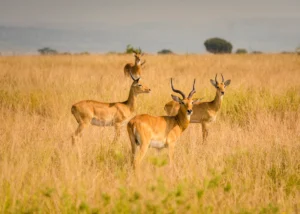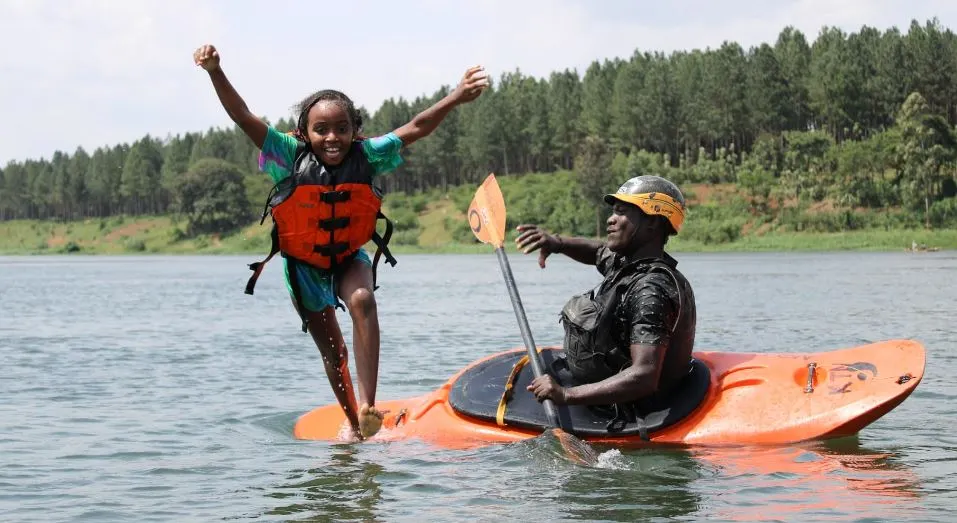Uganda, often referred to as the “Pearl of Africa,” is renowned for its breath-taking landscapes, diverse wildlife, and rich cultural heritage. While international tourists flock to experience Uganda’s beauty, it’s equally important for Ugandans to explore their own country.
Domestic tourism in Uganda not only fosters a deeper connection to one’s heritage but also significantly boosts the local economy. By traveling within Uganda, as a citizen you uncover hidden gems, support local businesses, and promote sustainable tourism practices in Uganda.
In this article, we delve into the myriad reasons why Ugandans should embrace domestic tourism and the benefits it brings to individuals and the nation as a whole.
1. Discover the Hidden Gems of Uganda
Uganda is often referred to as the “Pearl of Africa” for a reason. From the misty mountains of Bwindi Impenetrable National Park to the roaring waters of Murchison Falls, Uganda offers a variety of stunning landscapes and unique safari experiences. Exploring these local treasures can be just as exciting as traveling abroad.
2. Support Local Economies
Traveling domestically helps boost Uganda’s local economy. By visiting Uganda national parks, staying in local Uganda lodges, and dining at local Uganda restaurants, you contribute to the livelihoods of many Ugandans. This support is crucial for the growth and sustainability of the Uganda tourism sector, which employs everyone along the business value chain in Uganda.
3. Affordable and Accessible
Domestic travel in Uganda is often more affordable and accessible compared to international trips. You can save on travel costs and still enjoy luxurious stays in beautiful locations in Uganda that even international travellers fancy.
The beauty is that Uganda accommodation facility rates and park entrance fees are becoming more affordable. The Uganda government through the ministry of Tourism, Wildlife and Antiquities has maintained the promise of very low park entrance fees and accommodation at a few facilities under their management, and private investors are gradually considering rates for Ugandans and East Africans.
The COVID-19 pandemic communicated volumes for Uganda’s private tourism investors to consider targeting the domestic tourist too. This puts a domestic traveller exploring Uganda to a more logistical advantage!
4. Rich Cultural Experiences
Uganda is home to diverse cultures and traditions. It is an incredibly diverse country, with around 65 different ethnic groups and tribes. Each group has its own unique language, customs, and traditions, contributing to the rich cultural tapestry. Traveling within Uganda allows you to immerse yourself in these rich cultural experiences. Whether it’s participating in traditional dances, learning about local crafts, or tasting regional cuisines, domestic travel offers a deeper connection to your heritage as a Ugandan. You can only appreciate another culture when you have experienced it.
5. Wildlife and Nature Conservation
By visiting Uganda national parks and Uganda wildlife reserves, you play a role in Uganda’s conservation efforts. Your visit to Uganda helps fund the protection of endangered species such as Mountain gorillas and the preservation of natural habitats. Uganda’s national parks are home to incredible wildlife, including mountain gorillas, chimpanzees, elephants, and a variety of bird species.
6. Educational Opportunities
Traveling domestically can be educational for both adults and children. It provides an opportunity to learn about your country’s history, geography, and biodiversity. Educational trips to places like the Uganda Wildlife Education Centre can be both fun and informative.
7. Strengthen National Pride
Exploring the beauty and diversity of Uganda can instil a sense of pride and appreciation for your country. It fosters a deeper understanding and love for the land and its people, encouraging a collective effort to preserve and promote Uganda’s natural and cultural heritage as a citizen. Your identity should be a source of pride, because this cannot be negotiated beyond Uganda.
Plan Your Uganda Safari Adventure
Ready to explore Uganda? Here are some top safari destinations to consider on a journey to discover the wonders of Uganda and create unforgettable memories right at home
- Bwindi Impenetrable National Park: Famous for gorilla trekking.
- Murchison Falls National Park: Known for its powerful waterfalls and diverse wildlife.
- Queen Elizabeth National Park: Offers boat safaris and excellent Uganda bird watching.
- Kibale National Park: Ideal for chimpanzee trekking and primate viewing.
- Uganda national parks
More about Top Safari Destinations in Uganda
Bwindi Impenetrable National ParkBwindi Impenetrable National Park is a UNESCO World Heritage Site renowned for its biodiversity and dense rainforest located in southwestern Uganda. Covering approximately 331 square kilometres, the park is home to nearly half of the world’s population of endangered mountain gorillas.
Visitors often go Bwindi for the unique experience of gorilla trekking, where they can observe these magnificent creatures in their natural habitat.
In addition to gorillas, Bwindi hosts a variety of other wildlife, including over 120 species of mammals, 350 species of birds, and numerous butterflies and reptiles. The park’s lush vegetation and rugged terrain make it a haven for nature enthusiasts and adventure seekers alike.
 Gorilla Trekking: Bwindi is renowned for its mountain gorilla population. Gorilla Trekking through the dense forest to observe these majestic mountain Gorilla in their natural habitat is a once-in-a-lifetime experience. Bwindi Impenetrable national park is home to nearly half of the world’s total number of the surviving mountain gorillas.
Gorilla Trekking: Bwindi is renowned for its mountain gorilla population. Gorilla Trekking through the dense forest to observe these majestic mountain Gorilla in their natural habitat is a once-in-a-lifetime experience. Bwindi Impenetrable national park is home to nearly half of the world’s total number of the surviving mountain gorillas.
Biodiversity: Besides gorillas and gorilla trekking, Bwindi forest boasts a rich biodiversity, including over 120 mammal species, 350 bird species, and various butterflies and reptiles. The park’s lush vegetation and scenic landscapes make it a paradise for nature lovers.
Community Visits: After gorilla trekking in Bwindi forest, Engage with local communities through cultural tours. Learn about the Batwa pygmies, their traditions, and their way of life. These interactions provide a deeper understanding of the region’s cultural heritage and the appreciation of what comes with travel and diversity.
Murchison Falls National Park
 Murchison Falls National Park, is located in north-western Uganda, and is the country’s largest national park, spanning about 3,840 square kilometers. The park is named after the impressive Murchison Falls, where the Nile River squeezes through a narrow gorge and plunges 43 meters down, creating a spectacular waterfall.
Murchison Falls National Park, is located in north-western Uganda, and is the country’s largest national park, spanning about 3,840 square kilometers. The park is named after the impressive Murchison Falls, where the Nile River squeezes through a narrow gorge and plunges 43 meters down, creating a spectacular waterfall.
The park boasts a rich variety of wildlife, including elephants, lions, giraffes, and numerous bird species. Visitors can enjoy activities such as game drives, boat cruises on the Nile, and guided nature walks. Fishing, especially for Nile perch, is also popular.
Murchison Falls National Park is a favourite destination for both local and international tourists, offering a unique combination of breath-taking landscapes and abundant wildlife.
The Falls: Witness the spectacular Murchison Falls, where the Nile River plunges 43 meters through a narrow gorge. The sight and sound of the powerful falls are truly awe-inspiring.
Wildlife Safaris: The park offers excellent game viewing opportunities. You can spot the Big Five (lion, leopard, elephant, buffalo, and rhino) along with giraffes, hippos, crocodiles, and numerous antelope species. Boat safaris on the Nile provide a unique perspective on the park’s wildlife.
Bird Watching: Murchison Falls is a bird watcher’s haven with over 450 bird species, including the rare shoebill stork. The varied habitats, from riverine forests to savannahs, support a diverse avian population.
Queen Elizabeth National Park
 Queen Elizabeth National Park is located in southwestern Uganda. The park is one of the country’s most popular and diverse national parks. Established in 1952, it spans approximately 1,978 square kilometres and is known for its stunning landscapes, which include savannahs, forests, wetlands, and volcanic craters.
Queen Elizabeth National Park is located in southwestern Uganda. The park is one of the country’s most popular and diverse national parks. Established in 1952, it spans approximately 1,978 square kilometres and is known for its stunning landscapes, which include savannahs, forests, wetlands, and volcanic craters.
The park is also home to a wide variety of wildlife, including elephants, lions, hippos, and over 600 species of birds. One of its unique features is the tree-climbing lions found in the Ishasha sector. The park also offers boat cruises on the Kazinga Channel, providing excellent opportunities for wildlife viewing and birdwatching.
Boat Safaris: The Kazinga Channel, which connects Lake George and Lake Edward, is perfect for boat safaris. You’ll see hippos, crocodiles, and a variety of bird species up close. The channel is one of the best places in Uganda for bird watching.
 Tree-Climbing Lions: In the Ishasha sector of the park, you can find the famous tree-climbing lions. This rare behavior is a highlight for many visitors and offers unique photo opportunities.
Tree-Climbing Lions: In the Ishasha sector of the park, you can find the famous tree-climbing lions. This rare behavior is a highlight for many visitors and offers unique photo opportunities.
Crater Lakes: The park is dotted with beautiful crater lakes, each with its own unique ecosystem. Exploring the crater lakes in queen Elizabeth national park provides insight into the geological history of the region and offers stunning views.
Kibale National Park
 Kibale National Park, is located in western Uganda, and renowned for its lush evergreen rainforest as well as diverse landscapes. Covering approximately 766 square kilometres, the park is famous for its high concentration of primates, including endangered chimpanzees, red colobus monkeys, and the rare L’Hoest’s monkey. It is a prime destination for chimpanzee trekking, offering visitors the chance to observe these fascinating creatures in their natural habitat.
Kibale National Park, is located in western Uganda, and renowned for its lush evergreen rainforest as well as diverse landscapes. Covering approximately 766 square kilometres, the park is famous for its high concentration of primates, including endangered chimpanzees, red colobus monkeys, and the rare L’Hoest’s monkey. It is a prime destination for chimpanzee trekking, offering visitors the chance to observe these fascinating creatures in their natural habitat.
In addition to its primates, Kibale is home to over 300 bird species, making it a haven for birdwatchers. The park’s diverse ecosystems also include patches of grassland and swamp, providing a rich variety of flora and fauna. Visitors can explore the scenic trails, enjoy the vibrant wildlife, and experience the unique beauty of this remarkable national park.
Chimpanzee Trekking: Kibale is known as the primate capital of the world, with 13 primate species, including chimpanzees. Trekking to see these intelligent and social animals is a highlight of any visit.
Nature Walks: The park offers guided nature walks through its lush forests. These walks are an excellent way to experience the park’s flora and fauna, including various bird species, butterflies, and other wildlife.
Bigodi Wetland Sanctuary: Adjacent to Kibale forest, this community-run sanctuary is a great place for bird watching and spotting other wildlife. The sanctuary supports local conservation efforts and provides income for the community. When you visit, your contribution transforms the host community economically but also supports forest conservation.
Your Safari to Uganda’s top Tourist Destinations
When planning your safari, consider the best times to visit each park. For example, the dry seasons (June to September and December to February) are ideal for wildlife viewing as animals gather around water sources.
When you book your safari with us, we ensure you have the necessary permits for activities like gorilla and chimpanzee trekking, and book accommodations in advance, especially during peak seasons.
Refer to our Short Uganda safaris.

